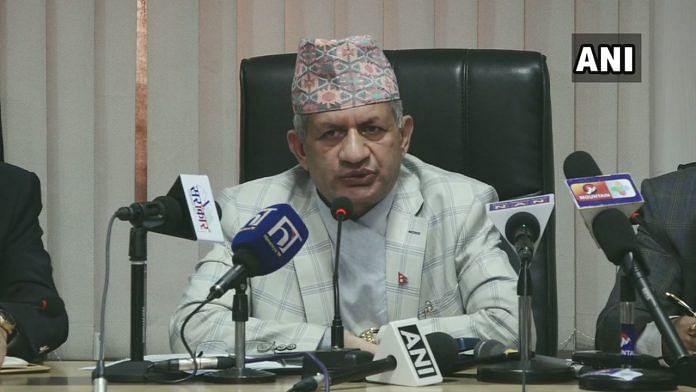New Delhi: Keeping aside the map row that kept bilateral ties between India and Nepal on tenterhooks last year, both sides now seem to be moving on a steady path of progress with New Delhi and Kathmandu holding the 6th Joint Commission meeting Friday.
This is the highest level dialogue mechanism between both the countries that takes place at the level of foreign ministers.
Nepal’s Foreign Minister Pradeep K. Gyawali arrived in New Delhi Thursday and prior to the Joint Commission meeting, he is scheduled to meet External Affairs Minister S. Jaishankar for a bilateral meeting Friday.
This is the highest-level visit from Nepal to India following the map row that threatened to disrupt the friendly ties between both the neighbours.
During the meeting, both sides are expected to discuss a range of issues — from the border row to faster implementation of projects by India in the Himalayan country — even as Kathmandu is now being run by an interim government after the informal split in the ruling Nepal Communist Party (NCP), sources told ThePrint.
According to the sources, Joint Commission meetings are usually structured with outcomes set beforehand. However, the fact that this will be preceded by a separate meeting between both the foreign ministers indicates a “thawing of ties”.
Sources also said while nothing concrete is expected to come out on the border row, a meeting of foreign secretaries of both countries may be announced that has the mandate to settle the Kalapani border issue.
Nepal is presently reeling under a deep political turmoil as the NCP has now split into two factions — one led by Prime Minister K.P.S. Oli and the other by Madhav Kumar Nepal and Pushp Kamal Dahal, or Prachanda, both former prime ministers. The country is currently run by a caretaker government.
Anurag Srivastava, spokesperson, Ministry of External Affairs, Thursday said the Joint Commission meeting will provide “political guidance to further enhance the special and unique ties that we enjoy”.
“We look forward to constructive discussions on the numerous sectors that encompass our bilateral agenda,” he said during a press conference.
“Our position on the boundary issue is well-known. Let me say that the JCM (Joint Commission meeting) and boundary talks are separate mechanisms,” he added.
Manjeev Singh Puri, former Indian ambassador to Nepal, told ThePrint: “The ups and downs in politics have always been a common feature in Nepal. This keeps happening, but bilateral ties must continue unimpeded. We have a huge relationship that carries on and should continue to carry on.”
“Geography demands, and the friendly relationship we maintain demands that we keep our bilateral ties intact and work together,” he added.
Last month, just as the NCP headed for a split, Beijing had sent a delegation under Guo Yezhou, vice minister, International Department of the Communist Party of China, to Kathmandu with the objective of uniting the NCP.
Also read: A stable Nepal is in India’s interest. Supporting Oli or hoping for Right-wing coalition isn’t
High-level visit by Indian leaders to Nepal after map row
Prior to Gyawali’s visit and despite India’s rejection of Nepal’s new political map, it was from India’s side that the high-level visits and talks resumed, starting with the visit of R&AW chief Samant Kumar Goel last October.
This was followed by Foreign Secretary Harsh V. Shringla’s visit to Kathmandu, in which he vowed to “take the ties forward” and held crucial meetings with Oli as well as other political leaders.
After this visit, India and Nepal also entered into an air bubble travel arrangement, while New Delhi committed to cooperate with Kathmandu in fighting the Covid-19 pandemic.
In November, Army Chief General M.M. Naravane had visited Nepal to receive the honorary rank of the General of the Nepali Army from President Bidya Devi Bhandari, a tradition that has been going on for decades now.
However, Naravane had sparked a row earlier in May when he said that Nepal was laying its claims on the Lipulekh border at the “behest of someone else”, indicating Chinese interference.
Nepal’s Defence Minister Ishwor Pokhrel had termed the remarks “insulting”.
Oli’s potshots at India
On 20 May 2020, Nepal officially released a new map, showing the disputed territories of Limpiyadhura, Lipulekh and Kalapani within its borders, thereby claiming an area of about 335 sqkm as its own, which was rejected by India.
The row became so intense that Oli even blamed New Delhi for spreading “Indian virus”, saying those coming from India to his country through illegal channels are spreading the novel coronavirus.
Oli had even ridiculed India’s national emblem, the Lion Capital, and motto ‘Satyameva Jayate’ (truth alone prevails), saying New Delhi is now following the motto “simheva jayate” (lion, signifying strength, wins).
Also read: Oli now says India has ‘encroached’ Nepal’s territory since 1962, should return it






